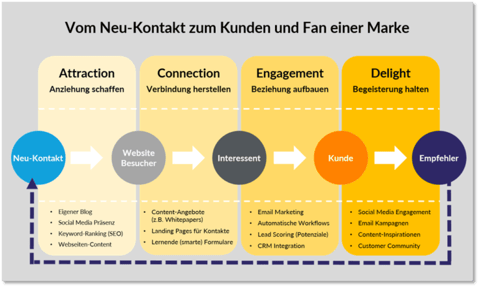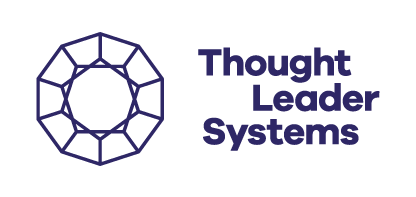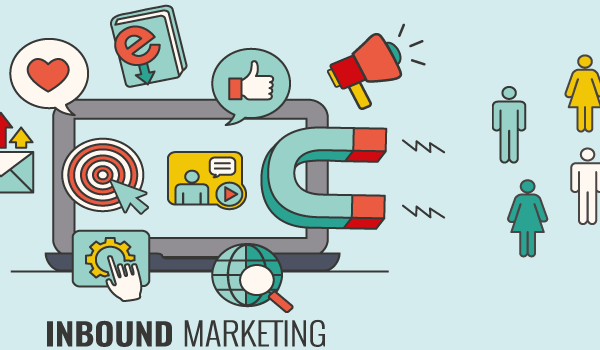Inbound marketing is a new term. It stands for modern marketing in the digital age and is aligned with new, digital customer behavior. Your customers do not want to be interrupted by a commercial during their favorite movie, nor disturbed by phone calls. Your customers search the internet for solutions, advice, tips, and tricks. 86 percent of all customers say that search engines help them learn something new or important about a product before they make their purchase decision. Only four percent of customers now make their purchase decision offline.
Why inbound marketing?
With inbound marketing, you provide your customers with compelling arguments instead of prefabricated advertising messages. You deliver the exact content people need at the desired time. With high-quality content, you can effectively convince new customers of your authority. You gain trust and build relationships. You guide customers precisely to the products and solutions they are actively searching for on the web.

Content is the magic word in inbound marketing. Content marketing opens doors to highly efficient and sales-promoting marketing. The right content at the right time for the right person counts. The more specifically you define what you want to achieve (e.g., acquiring new customers, finding qualified applicants, or improving your image), the more effective your inbound strategy with content marketing will be.
What does inbound marketing achieve?
Marketing today only works with the right mix of all channels. Inbound marketing connects and manages many of these marketing channels and integrates them into a holistic system, including:
- Content marketing and blogging,
- Email marketing and newsletter marketing,
- Search engine optimization (SEO),
- Paid search ads (SEA) such as Google Ads,
- Social media marketing.
You are supported by specialized marketing automation software, which allows you to design and optimize all campaigns in real-time. With such software, you can centrally manage, monitor, evaluate, and continuously optimize or adjust almost all online marketing activities. This way, you can achieve multiple marketing goals at once—effectively, quickly, and measurably. This methodology and its benefits make inbound marketing an important component of thought leadership marketing.
The inbound method helps you or your sales team to spend time only with promising potential customers. You focus your marketing campaigns consistently on lead generation and customer engagement. As a result, the cost per new customer contact can decrease by up to 62 percent compared to other marketing methods.
You can use all conceivable options to present content that resonates with your desired target audiences (buyer personas). It is important to understand the problems of your target groups in order to provide solution-based content.
Inbound marketing in practice - an example
Peter is searching for a solution to his problem and enters relevant search terms into Google. The search engine provides him with precise results. Peter looks at the first two pages of results and clicks on various links that seem particularly relevant.
He lands on a company's website that describes his problem accurately. After a few clicks, the site offers additional solution ideas. Peter immediately identifies with the content and feels understood. His curiosity drives him further, and he decides to download a free white paper on his topic. In exchange for this valuable and personally useful content, Peter willingly provides his email address and even subscribes to the blog.
The white paper helps Peter with his decision-making. He has built trust with the provider and is convinced of their expertise. Consequently, he responds positively to subsequent emails from the company. So much so that he eventually schedules a phone consultation. Peter becomes a customer of the company, is enthusiastic, and even becomes a fan and promoter of the brand.
From the company's perspective, Peter is initially a stranger to the website. By downloading the white paper, Peter is identified as a known prospect or lead. With the scheduling of the phone consultation, he becomes a so-called Qualified Lead. Through inbound marketing, the provider has effectively guided Peter along his customer contact path—the so-called Customer Journey or Buyer's Journey—and supported him towards making a purchase.
Who is an inbound marketing strategy suitable for?
Inbound marketing is informative, educational, supportive, and builds trust. Today, no customer has the time to be presented with various portfolios by multiple representatives. They need to be selective. Customers need truly relevant and problem-solving content at the right time to remember the standout provider—their Thought Leader.
This means that, to create truly relevant content, you must know which stage of the buying process (Customer Journey) a potential buyer is currently in: still in the Awareness Phase, already in the Consideration Phase, or perhaps already in the Decision Phase?
Inbound marketing is a sophisticated, comprehensive, and effective method that can be used in any company. The ten key steps for implementing inbound marketing are:
- Analyze your current web and social media reach.
- Set your marketing goals (e.g., customer acquisition, reach, lead generation).
- Choose the appropriate marketing automation software (e.g., HubSpot, Marketo, Act-On).
- Define your buyer personas, i.e., detailed profiles of your ideal customers.
- Analyze your customers' decision-making process (Customer Journey).
- Find and create relevant content with professional content marketing.
- Define the relevant channels for reaching potential customers (social media, blog, email).
- Distribute the content, i.e., engage in active content distribution.
- Convert anonymous website visitors into genuine prospects (qualified leads).
- Measure the success of your inbound marketing campaign and continuously optimize content, customer engagement, and campaign mechanisms.
Conclusion
Inbound marketing stands for "attracting customers through information" and can become a turbo for your lead and customer acquisition. You achieve more leads and revenue with significantly lower costs compared to traditional marketing.
Thus, inbound marketing is much more effective and suitable for customer acquisition and thought leadership than, for example, advertising, direct mail, or social media alone. Thanks to automated processes, all your inbound campaigns are immediately visible, and success results are available at a glance in real-time. The outcome is long-term customer retention and high customer loyalty.


